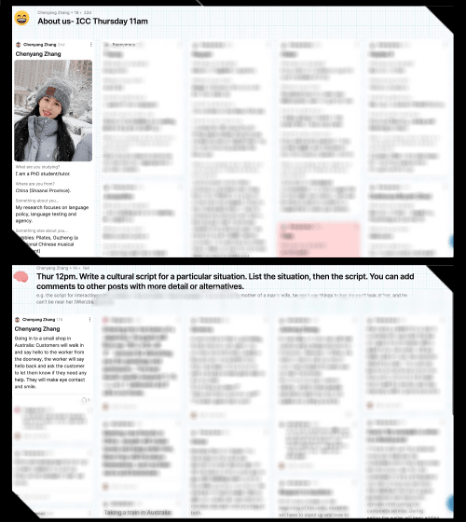
“I believe my improvement happened step by step, because…”: Embarking on Chenyang’s teaching adventures
Chenyang Zhang
Hello, dear readers! Welcome to my story zone. I’m Chenyang Zhang, a third-year PhD candidate in the School of Languages and Linguistics at the University of Melbourne. As you might recall, I had the pleasure of being interviewed by my colleague, Hangyu, and sharing my research project last year through SOLL Talk. Today, in my new role as a Graduate Research Teaching Fellow (GRTF), I’m excited to have you know about my teaching journey.
Before unfolding my story, I want to express my gratitude to the Intercultural Communication (ICC) coordinator, Dr. Debbie Loakes, whose unwavering support has given me the courage to take the first step on my teaching journey. I’m also thankful for our ICC team, where we can openly discuss teaching strategies with each other before or after our tutorials every week. Of course, none of this could’ve happened without the encouragement of my supervisors, A/Prof Jason Fan and Dr Kellie Frost. Their trust gave me the push to become a GRTF. Now, I am eager to share this ‘becoming’ progress, focusing primarily on the following two aspects.
Going all out in tutorial preparation to build up confidence
“Thump, thump, thump,” I could hear the drumroll of my heartbeat clear; it was February 29th, 10:45 am, just ten minutes away from stepping into the classroom for the first-time teaching. Taking sips of water and deep breaths, I tried to get rid of butterflies in my stomach. At that moment, I told myself “I should be confident since I have prepared a lot.”
Regarding preparation, the most important is to get familiar with the teaching materials and understand how teaching activities should be organised. For these two parts, thankfully, Debbie always prepared a detailed teaching outline for each tutorial. Through this outline, I learned the main teaching objectives for each tutorial, what types of teaching activities would be implemented, and what students could expect to learn in each activity. Besides, as a beginner tutor, another critical consideration is pedagogy, especially for how to engage students in each learning activity to achieve teaching goals. To navigate this aspect, I took the initiative to sit in Debbie’s classes during the first couple of weeks to observe how her tutorial unfolded.

After becoming familiarised with what and how to teach, in the first three weeks, I scripted every word I intended to convey and then rehearsed multiple times. Not content with solo preparation, I sought the assistance of my colleagues, Niles and Hangyu, for a teaching dry run; as shown in the above picture, Hangyu captured the moment. Their feedback uncovered aspects that I hadn’t considered, yet proved incredibly useful; for instance, they suggested shortening URL links that were used in each activity for easier student access to learning resources. Incorporating their suggestion, I conducted my final two or three teaching rehearsals with my partner every Wednesday evening. After all the groundwork, I felt more confident to step into my role as a tutor for the upcoming teaching day.
However, what would happen in class and how to cope with it? These were mysteries to me before each tutorial. Only through experience, I could unlock the secrets to enhance my teaching ability and facilitate my students’ learning.
Learning from each tutorial to accumulate experience

To accumulate teaching experience, what I aimed to do was to find teaching challenges and address them before the next tutorial. For instance, during the initial two weeks of tutorials, I noticed that some students were not as actively engaged in group activities as I had hoped. Recognising this, I’ve embraced two ways for teaching improvement: self-exploration and the guidance of colleagues. On one hand, I’ve immersed myself in teaching videos online, particularly focusing on active learning strategies. At the same time, I was lucky enough to meet Josh (a senior tutor in Linguistics), who shared really practical advice with me such as engaging in different group discussions and providing a summary when no volunteer emerged after group activities. Also, Debbie recommended integrating Padlet as a tool for quiet students to share their ideas, which proved effective in my tutorials, as illustrated in the accompanying photo above.

Besides self-discovery and expert guidance, learning from students is equally invaluable. As part of my teaching routine, I often allocated extra time after class to remain available for students to ask questions or seek clarification. This is an opportunity for mutual learning. For example, if two or more students raised similar questions, I took it as an opportunity to reflect on whether I conveyed the teaching points clearly during class. In the recent two weeks, I’ve noticed a growing number of students engaging with me outside of class during my consultation time. They reached out to discuss course-related topics, seek assistance with assignment challenges, and share their future learning plans. Whenever I can provide assistance and support to my students, it brings me immense joy.
I am sincerely grateful for the trust that students place in me and the support from my colleagues. Under this teaching environment, I believe my improvement happened step by step because I am currently pursuing and hopefully will achieve my goals of fostering confidence and expertise in my teaching field.
To everyone who has followed along with me on this journey, I want to express my deepest gratitude. Thank you.